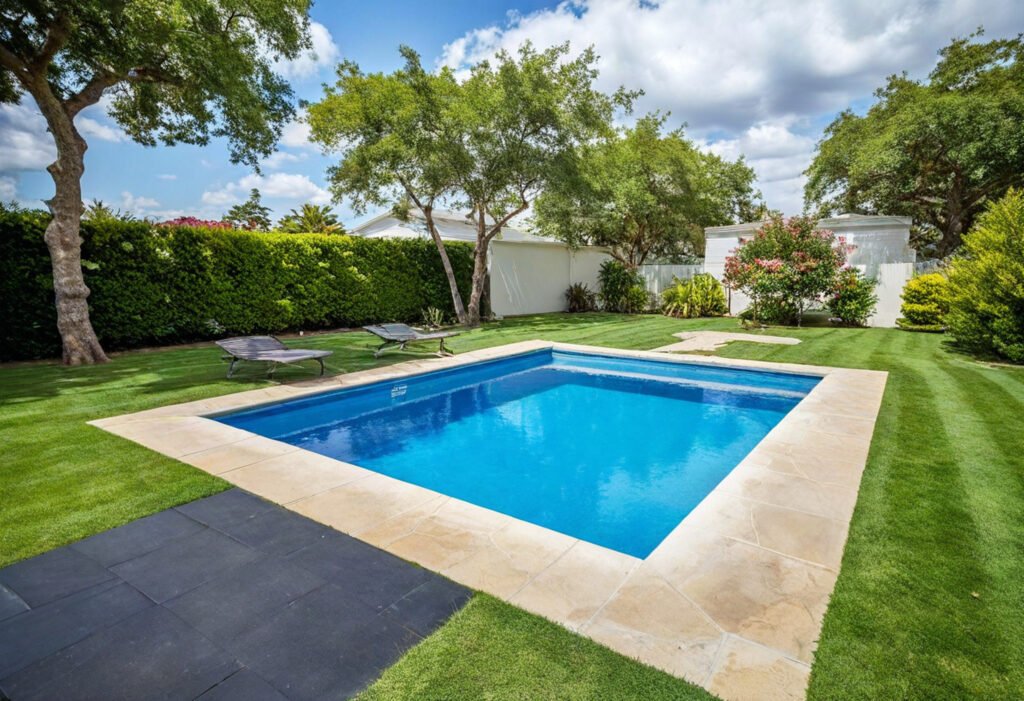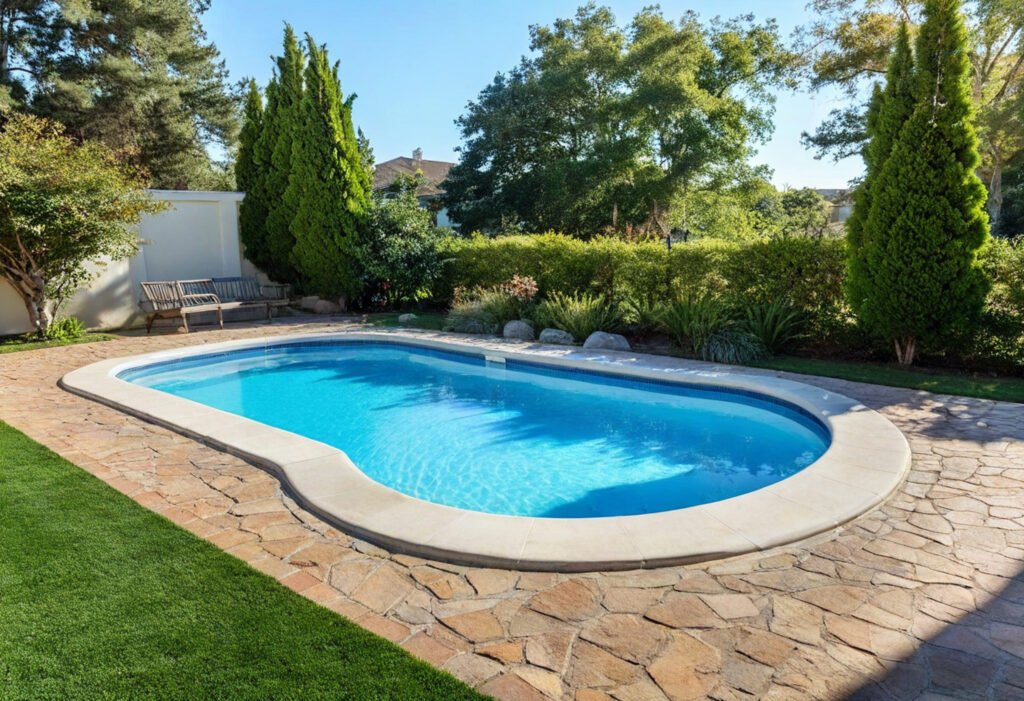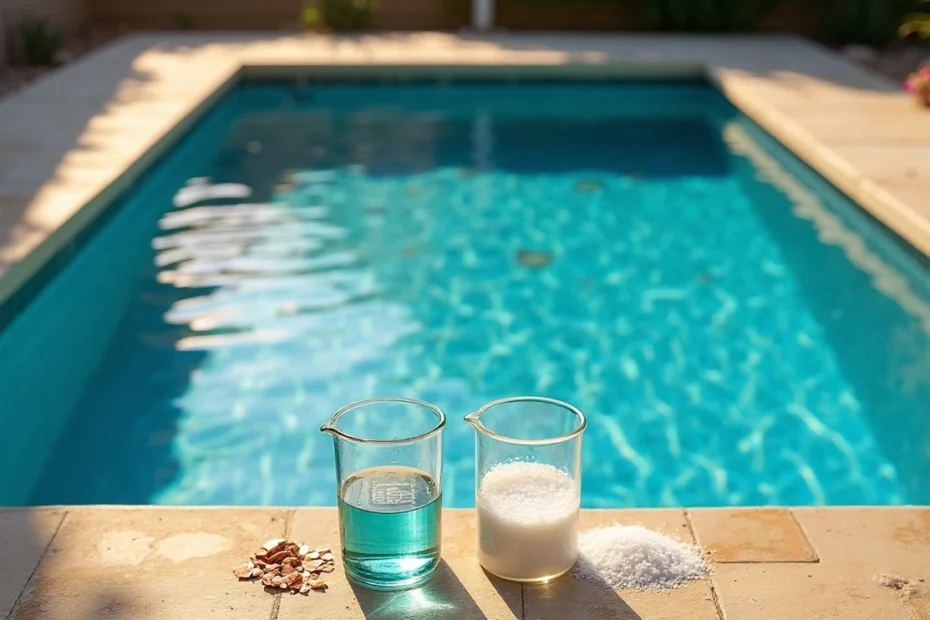Pool owners often face a tough choice between mineral and saltwater systems. Many wonder about mineral pools and if they’re worth the money. Swimming in mineral-rich water has been popular since ancient times, and its therapeutic benefits still attract pool owners today.
Saltwater systems cost between $1,000 and $2,500. Mineral water systems offer a budget-friendly choice that starts at around $700. A mineral pool system can cut your chlorine use by up to 50%. These pools work differently from traditional chlorine pools. They use natural elements like copper, silver, and zinc to clean the water. The system still needs a chlorinator that creates chlorine from these minerals instead of salt.
This piece will compare mineral and saltwater pool options. We’ll look at the real costs of each system and help you pick the best solution for your budget and lifestyle priorities.
Understanding Saltwater Pools
First-time pool owners often misunderstand saltwater pools. These systems don’t eliminate chlorine – they just produce it differently through electrolysis.
How saltwater chlorinators work
Saltwater chlorinators convert salt (sodium chloride) into chlorine using an electrolytic cell. Pool water with dissolved salt flows through the cell where an electrical current splits the salt molecules. This creates hypochlorous acid—the same sanitizing agent found in traditional chlorine pools. The cell’s metal plates come coated with ruthenium or iridium, which helps this conversion. The control board lets you adjust chlorine output based on your pool’s needs.
These systems work best with salt levels between 2,700-3,400 parts per million (ppm), and 3,200 ppm gives ideal results. The concentration sits at about 1/12 of ocean water’s salinity—making it less salty than human tears.
Original setup and installation costs
Saltwater systems need a bigger upfront investment than traditional chlorination. Quality salt chlorinators cost between $700 and $1,200. Professional installation can bring total conversion costs to $600-$2,500 depending on your pool’s size and complexity.
New pool installations average around $25,000 compared to $23,000 for traditional chlorine pools. The long-term savings make up for this extra cost.
Ongoing maintenance and salt cell care
Saltwater pools need regular maintenance. You’ll need to:
- Test and balance pH, alkalinity, and calcium hardness regularly
- Check the salt cell every three months for scale buildup
- Clean the cell with a diluted acid solution when needed
- Keep an eye on salt levels and add more after heavy rain or backwashing
A salt cell that’s well cared for lasts 3-7 years before needing replacement. New cells cost between $300-$800.
Common misconceptions about saltwater systems
People have many wrong ideas about saltwater pools. Here’s the truth:
Salt systems make their chlorine instead of being chlorine-free. The water contains about 1/10 the salt of ocean water – not too salty at all. The maintenance needs change rather than disappear, with fewer chemicals but different care requirements.
The cost factor surprises many people. Annual chemical expenses range from $100-$400 for salt pools while traditional chlorine pools need $370-$900.
Exploring Mineral Pool Systems

Mineral pools represent a development in swimming pool technology and are a middle ground between traditional chlorine and saltwater systems.
What is a mineral swimming pool?
A mineral swimming pool employs naturally occurring minerals like magnesium, potassium, copper, and silver to sanitize water. As with saltwater systems, mineral pools use a chlorinator that converts these minerals into small doses of active chlorine through electrolysis. These systems stand apart because of their mineral composition. Most systems contain a special blend of minerals that work together to purify water and provide benefits that standard chlorine or salt systems can’t match.
Key minerals used and their effects
The primary minerals found in these systems include:
Magnesium – This natural flocculant removes excess particles and creates cleaner, clearer water. It also acts as a water softener that gives water a silky texture.
Potassium – This mineral works alongside magnesium to maintain pH balance and improve water quality.
Silver – The antibacterial properties in silver effectively sanitize water, a method dating back to ancient Roman times.
Copper – This mineral acts as a powerful algaecide and prevents algae growth without harsh chemicals.
Premium systems like MagnaPool® combine magnesium and potassium while staying 100% sodium-free.
Mineral pool benefits for skin and health
Mineral pools offer significant health benefits beyond clean water. These pools need up to 50% less chlorine, which means swimmers face fewer irritants. The water becomes gentler on skin, eyes, and hair. People with sensitive skin or conditions like eczema, psoriasis, or dermatitis find swimming more comfortable.
The skin absorbs magnesium (transdermal absorption), which helps reduce muscle tension, improves circulation, and eases stress. Research indicates that mineral bathing improves skin texture and elasticity while potentially reducing inflammation.
Compatibility with existing pool setups
Your existing pool infrastructure usually won’t need replacement when converting to a mineral system. Standard filtration equipment works with most mineral systems, including chlorinators that can handle mineral content. The switch mainly involves draining some water, adding mineral blends, and sometimes upgrading to a compatible chlorinator.
Glass media filtration pairs well with mineral systems and works better than sand to boost water clarity and reduce maintenance needs.
Cost Comparison: Mineral vs Salt Water Pool
Your budget shapes the choice between mineral and saltwater pool systems. Let’s get into the financial aspects of both options.
Upfront installation costs
Mineral water systems give you a more budget-friendly original option, with prices starting around $700. Saltwater systems need a higher upfront investment. They start at about $800 but can range between $1,000 and $2,500 based on pool size and features.
Complete pool installations cost around $25,000 for a saltwater pool and $23,000 for a traditional system. We needed specialized equipment which caused the price difference.
Ongoing maintenance and chemical expenses
Mineral pools need regular cartridge replacements every 6 months that cost between $100-$150 each. The mineral bags cost about $30 for 3kg.
For larger installations:
- 30,000L mineral pools need 10-12 bags of minerals yearly (roughly $500/year)
- 50,000L pools need 15-20 bags (about $750/year)
Saltwater pools use cheaper salt (around $10 for a 25kg bag), with yearly costs between $120-$180. Traditional chlorine pools usually cost $400-$600 in annual chemical expenses.
Equipment longevity and replacement
Equipment lifespan is a key cost factor. Mineral systems cause less corrosion and wear on pool components. Salt cells need replacement every 3-6 years and cost between $500-$800.
Hidden costs to think about
Mineral pools use less electricity and need fewer backwash cycles. This saves thousands of gallons yearly. The water savings add up meaningfully over time.
Saltwater systems need corrosion-resistant materials and can harm surrounding landscaping. Salt pools might also need resurfacing more often—every 3-7 years compared to 10 years for traditional pools.
Mineral pools have higher upfront costs but lower long-term maintenance expenses, especially with chemical usage and equipment preservation.
Which Pool System is Right for You?

Your priorities and specific circumstances will determine the right pool system for you. A perfect balance between health benefits, maintenance needs, and budget limits will give you years of swimming enjoyment.
Factors to consider: skin sensitivity, budget, maintenance
Mineral swimming pools give the most important advantages to swimmers with sensitive skin conditions. Anyone can swim in mineral pools because the water won’t irritate their eyes, skin, and mucous membranes—even those with eczema, psoriasis, or dermatitis. Many users who couldn’t enjoy their pools because of constant irritations now swear by mineral systems. These systems generate 40% fewer chloramines than saltwater solutions.
Your timeframe affects budget choices:
- Original investment: Mineral systems usually cost around $700, while saltwater systems start at approximately $800
- Ongoing expenses: Mineral pools need cartridge replacements every 6 months ($100-$150), while saltwater systems require salt cell replacements every 3-5 years ($300-$600)
Fiberglass pools need the least upkeep among all three major pool types. They cost only $3,750 over 10 years compared to $11,500 for vinyl liner pools and $27,400 for concrete pools.
Eco-friendliness and chemical usage
Mineral pools excel environmentally because they need up to 50% less chlorine. Systems like MagnaPool use recycled glass filter media that provide finer filtration and remove tiny particles without extra chemicals.
Natural pool options exist for eco-conscious swimmers. Wetland pools use plants to filter water and eliminate chemicals. These green alternatives go together with the environment and reduce carbon footprints.
Long-term value and user experience
Users consistently praise mineral systems’ exceptional water quality. One user notes: “The water quality is second to none and is gentle on the most sensitive of skin”. Another states: “I’ve now had this system for over 2 years—it’s been amazing, no more chemicals”.
Mineral pools offer more than comfort. They provide therapeutic benefits through magnesium absorption through the skin, which helps reduce muscle tension and stress. It also stays 100% salt-free, giving superior water softness that many swimmers call “silky”.
Your ideal choice depends on what matters most to you – therapeutic benefits, budget limits, or simple maintenance.
Conclusion
Your specific needs and priorities determine the choice between mineral and saltwater pool systems. Both options are better than traditional chlorine pools. Mineral pools excel with gentler water quality and therapeutic benefits while using less chlorine. Saltwater systems provide a time-tested solution that needs predictable maintenance.
The cost comparison helps make this decision easier. Mineral systems cost less up front at around $700, but you’ll spend more on regular mineral cartridge replacements. Saltwater pools need more money initially but could save some owners money over the last several years.
Swimmers who care about health will love how mineral pools make water feel soft and don’t irritate their eyes, skin, or hair. This makes mineral systems a great option for families with sensitive skin or frequent swimmers.
Both systems cut down the harsh chemical effects you get with traditional chlorine pools. Your budget, health requirements, and maintenance priorities should point you to the right choice. The therapeutic qualities of mineral-rich water or the proven reliability of saltwater systems – either way, you’ll enjoy swimming more with a system that fits your lifestyle.
